India-EFTA trade agreement: Prospects and challenges
Founded in 1960, EFTA facilitates free trade for countries outside the European Community, and currently includes Switzerland, Norway, Iceland and Liechtenstein.
Negotiations on a broad-based India-EFTA Trade and Investment Agreement were officially launched in January 2008, based on recommendations made by a Joint EFTA-India Study Group. The 21st round of discussions was held in Delhi from January 8-13, 2024, which mainly focused on areas of trade in services, rules of origin, trade facilitation, investment promotion and cooperation, intellectual property rights, and trade and sustainable development.
Recent ministerial meetings demonstrate the commitment to reaching a mutually beneficial agreement. Economic ties, flourishing over two decades, have seen merchandise trade reach US$ 5.9 billion in 2023. The article highlights key sectors driving India-EFTA trade relations, future potential and key issues in their trade negotiations.
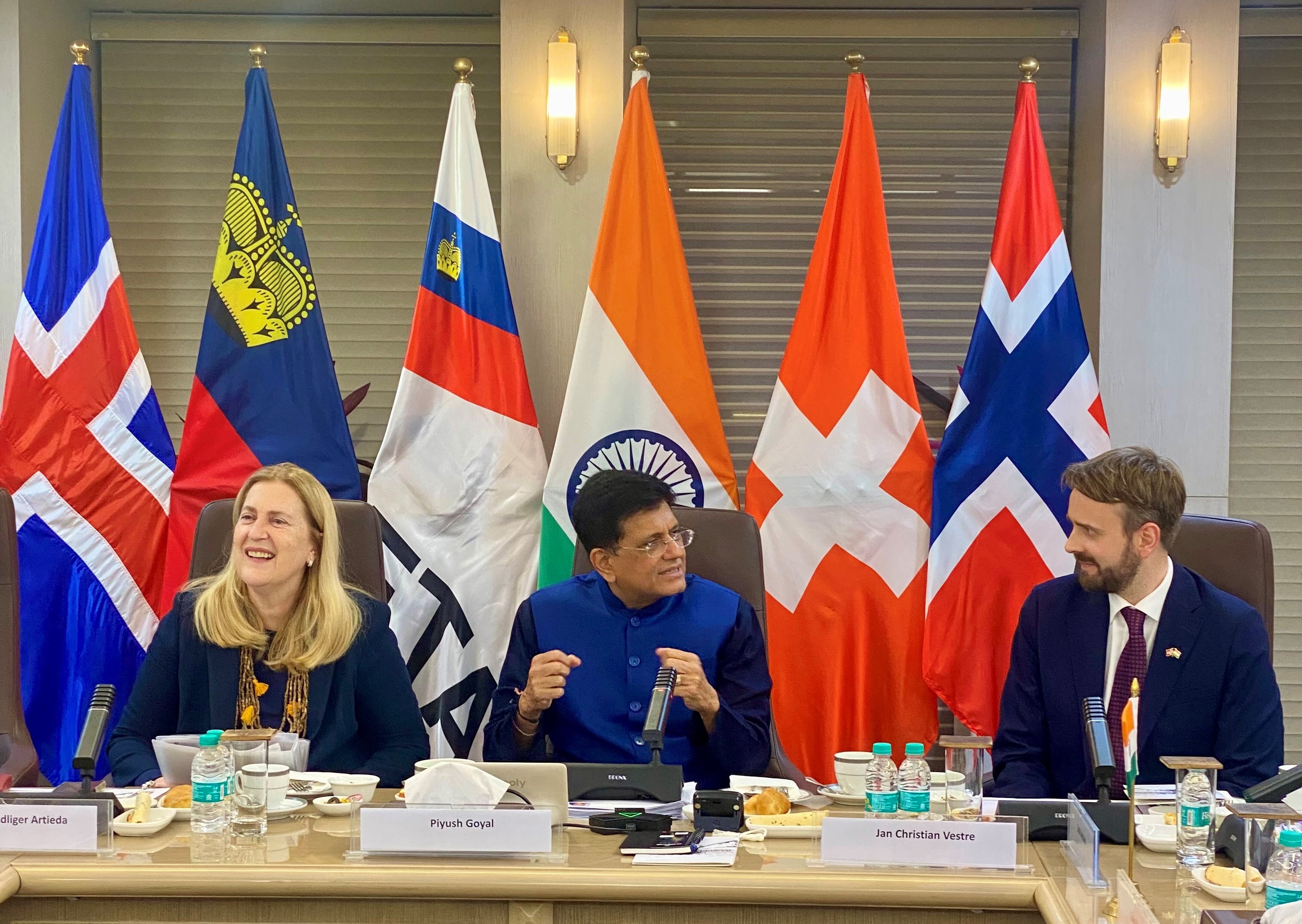
Image Source: efta.int
The European Free Trade Association (EFTA) is an intergovernmental organization established to promote and enhance free trade, serving as an alternative for countries not wishing to join the European Community (EC). Founded on May 3, 1960, through the Stockholm Convention, the initial members were Austria, Denmark, Great Britain, Norway, Portugal, Sweden, and Switzerland. Presently, EFTA’s membership is limited to Switzerland, Norway, Iceland, and Liechtenstein, which are not part of the European Union. EFTA has 29 free trade agreements (FTAs) with 40 partner countries, including Canada, Chile, China, Mexico, and Korea.
In May 2005, during the Indian President’s visit to Iceland, the country proposed negotiating a Free Trade Agreement (FTA) with India. Subsequently, in January 2006, the Swiss Federal Councilor, Head of the Federal Department of Economic Affairs, suggested exploring a Preferential Trading Arrangement (PTA) between India and EFTA during a meeting with the Commerce & Industry Minister in New Delhi. This proposal was reiterated in October 2006.
To delve into the economic ties between India and EFTA and assess the feasibility of a comprehensive trade and investment Agreement, a Joint Study Group (JSG) was formally initiated on December 1, 2006. The JSG’s report, completed in October 2007, consisted of nine chapters covering Introduction, Trade in Goods, Trade in Services, Investment, SPS/TBT and TF, IPRs and Competition, Government Procurement and Dispute Settlement, Technical Cooperation, and Conclusions and Recommendations.
The JSG findings indicated substantial mutual benefits from a comprehensive bilateral trade and investment Agreement, prompting the recommendation to commence negotiations.
With the negotiations for the EFTA-India Trade and Economic Partnership Agreement (TEPA), two online Ministerial meetings took place. Negotiations have intensified over the past few months. The EFTA States and India met for their 20th round of negotiations in November 2023 in Geneva, Switzerland.
On December 13, 2023, Shri Piyush Goyal, Minister of Commerce & Industry, Consumer Affairs & Food & Public Distribution, and Textiles represented India, while Helene Budliger Artieda, Swiss State Secretary at the State Secretariat for Economic Affairs (acting as the EFTA Spokesperson), Jan Christian Vestre, Minister of Trade and Industry of Norway, Martin Eyjólfsson, Permanent Secretary of State of Iceland, Ministry for Foreign Affairs, and Kurt Jäger, Ambassador, Permanent Representative, Permanent Mission of Liechtenstein to EFTA, WTO, and the UN, Geneva, represented EFTA. The 21st round of negotiations was held in January this year.
Both parties anticipate further meetings at both Ministerial and negotiating team levels in the coming days, underscoring their commitment to concluding discussions and achieving a mutually beneficial agreement at the earliest.
Focus areas of EFTA-India Trade and Economic Partnership Agreement (TEPA)
The proposed India-EFTA Trade and Economic Partnership Agreement (TEPA) primarily focuses on reducing tariffs for high-value goods like fish from Iceland and Norway, advanced chemicals, pharmaceuticals, machine equipment, and Swiss chocolate. India aims to attract investments and gain access for its goods in EFTA markets.
Under the agreement, EFTA nations will have the opportunity to export processed food and beverages, electrical machinery, and other engineering products to a potential market of 1.4 billion people at lower tariffs. Moreover, the pharmaceutical and medical devices industry within the EFTA bloc is poised to benefit from this deal.
India is also seeking investments from EFTA nations in both existing and new manufacturing projects, whether from the private sector or state-sponsored entities. Furthermore, the agreement could facilitate easier professional mobility for Indians within the EFTA bloc. Improved market access for agricultural products, including rice, which is minimally cultivated in the region, would be a significant advantage for India.
EFTA bloc trade With India
Economic ties between the EFTA States and India have witnessed consistent growth over the last twenty years. In 2023, the aggregate merchandise trade between EFTA and India exceeded US$ 22.33 billion. Notably, the EFTA States predominantly imported organic chemicals (33.2%); while their main exports to India, included natural pearls, precious stone metal etc; (81.7%) and mineral fuels & oil products (3.8%). Additionally, services trade and foreign direct investment have also attained significant levels.
India’s exports to the trading block during 2023 stood at US$ 1.9 billion against US$ 1.8 billion in 2022. Imports aggregated at $20.45 billion during the last calendar year compared to $17.32 billion in 2022.
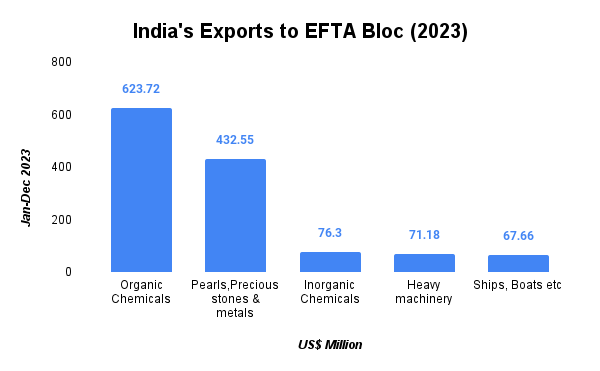
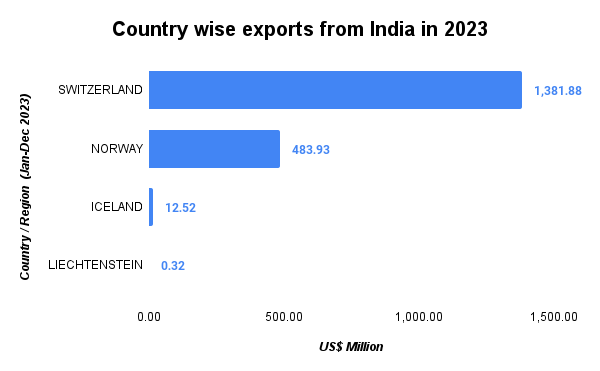
Source: DGCIS
India’s top 5 exported products to the EFTA bloc makes up to more than 67% of the total exports of US$ 1.87 billion. Where India’s export to the trading bloc was led by organic chemicals which holds a share of 33.2% in total exports to the bloc.
Organic Chemicals: India’s organic chemicals export reached US$ 623.72 million in 2023, showcasing a minimal growth with a CAGR of 0.03% over the period from 2019 to 2023. This indicates a stable market in the export of organic chemicals, reflecting the sector’s competitiveness and steady market demand.
Natural Pearls, Stones, Metals, etc. : The export of natural pearls, stones, metals, etc., amounted to US$ 432.52 million in 2023, with a CAGR of 11.19% during the period from 2019 to 2023. This suggests an increase in the demand and potential of this specific category of exports.
Inorganic Chemicals: India’s exports of inorganic chemicals reached US$ 76.3 million in 2023. with a CAGR of 7% between the 2019 and 2023. Indicating a positive growth in the sector and exports of the products.
Heavy Machinery and Products: The heavy machinery and products sector faced an increase in exports recording US$ 71.18 million in 2023, with a CAGR of 4.2% from 2019 to 2023. This depict an increase in demand and potential in the market.
Ships, Boats and parts: The category of product has recorded an export of US$ 67.66 million in 2023 with a CAGR of 3.78% between 2019 and 2023 with 3.6% share in exports to the trading bloc.
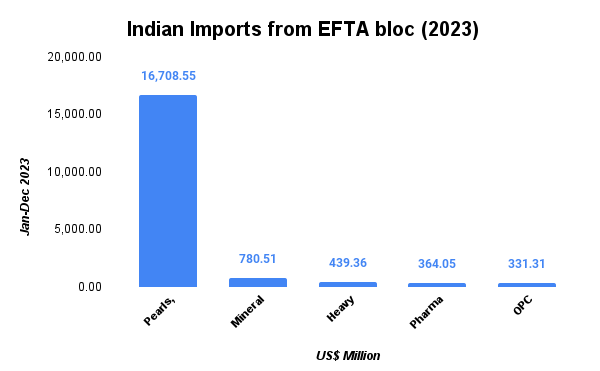
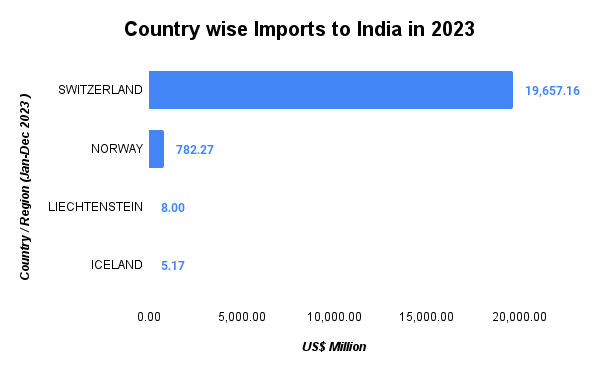
Source: DGCIS
Top 5 imported products by India alone makes up to more than 90% of the imports from the EFTA bloc. This is led by natural pearls, precious stones & metals making up to 81.7% of the total imports from the block to India.
Natural pearls, precious stones, metals, etc.: In 2023, the imported value of products within this category was US$ 16.708 million. However, there was a nominal growth with a CAGR of 2% from 2019 to 2023, indicating a steady demand in imports over that period.
In essence, the commodity that dominates India’s imports under this HS code from EFTA is gold (HS 7108), of which Switzerland is the world’s largest exporter.
Mineral fuels, mineral oils: In 2023, the imports of products in this category were valued US$ 780.5 million. It experienced significant growth with a CAGR of 16.6% from 2019 to 2023, indicating a substantial increase in value over the four-year period.
Heavy machinery and products: In 2022, the value of products in this category was US$ 439.6 million. It showed moderate growth with a CAGR of 5.3% from 2019 to 2023 indicating the increasing demand of the product category.
Pharmaceutical products: This category encompasses medications and healthcare-related products. In 2023, the value of pharmaceutical products was $364 million. It experienced solid growth with a CAGR of 5.27% from 2019 to 2023, indicating a significant increase in value over the four-year period.
OPC Devices: This refers to Optical, Photographic, Cinematographic devices, which could include various consumer electronics or gadgets. In 2023, the value of OPC devices was US$ 331 million. However, it saw comparatively less growth with CAGR of 1.09% from 2019 to 2023, indicating a less growth in import value over the period.
Challenges
While expressing optimism at an early conclusion of the FTA, Shri Piyush Goyal has also cautioned that EFTA countries need to recognise the interests of India for a fair, balanced and equitable agreement. He highlighted the difference in per capita incomes between India (US$ 2,500) and the EFTA countries (US$ 60,000-70,000). Further, he cited the example of the fisheries industry. EFTA nations have around 6,000 fishermen, while India has around 4 million, which are relatively small and marginalised. Moreover, the investments in Norway’s fishermen is many times higher as compared to India. So an FTA must consider ways and means to provide equal opportunity for the latter to catch up.
Anticipation is high for a potential free trade agreement between India and the European Free Trade Association (EFTA). However, a persistent concern revolves around intellectual property rights, particularly in the pharmaceutical sector. Switzerland and Norway, EFTA members, host key pharmaceutical companies, raising issues related to patenting, compulsory licensing, and the emerging challenge of data exclusivity.
This provision, present in European agreements, could impede India’s drug industry, a major exporter of affordable drugs. India has recently rejected the demand of the four-nation European Free Trade Association (EFTA) for ‘data exclusivity’ provisions in the free trade agreement that both sides are currently negotiating.
The proposed data exclusivity provisions, insisted upon by EFTA nations, would prevent domestic generic drug manufacturers from utilizing data from preclinical tests and clinical trials conducted by the original patent holders. If they wish to launch their version of an off-patent drug, they would need to either generate their own clinical data or wait until the exclusivity period concludes.
The Indian government, committed to safeguarding the interests of the domestic generic drug industry, has adamantly opposed the inclusion of data exclusivity in ongoing trade negotiations with EFTA. India remains committed to supplying affordable generic medicines globally and has firmly rejected EFTA’s demand for the data exclusivity clause in the free trade agreement talks.
The domestic generic drug industry has applauded the Commerce Ministry’s resolute stance against the inclusion of data exclusivity in the proposed free trade agreement with EFTA.
The outcome of these negotiations will not only impact trade relations of India and EFTA bloc but also help shape the future trajectory of the pharmaceutical industry and intellectual property rights.
Conclusion
The ongoing negotiations between India and the European Free Trade Association (EFTA) for a comprehensive trade agreement hold promise for economic collaboration. While the proposed India-EFTA Trade and Economic Partnership Agreement (TEPA) aims to enhance trade in high-value goods, concerns regarding equitability and data exclusivity will need to be resolved for the agreement to be finalised.
According to recent news, the EFTA members are possibly easing on their position on the issue of intellectual property rights. Further, the Indian side has sought the inclusion of a commitment wherein EFTA members would invest around US$ 100 billion over the next 15 years. Signs of an early conclusion of the deal are seen as immensely positive, as they could also help India balance the huge trade deficit with the EFTA region.







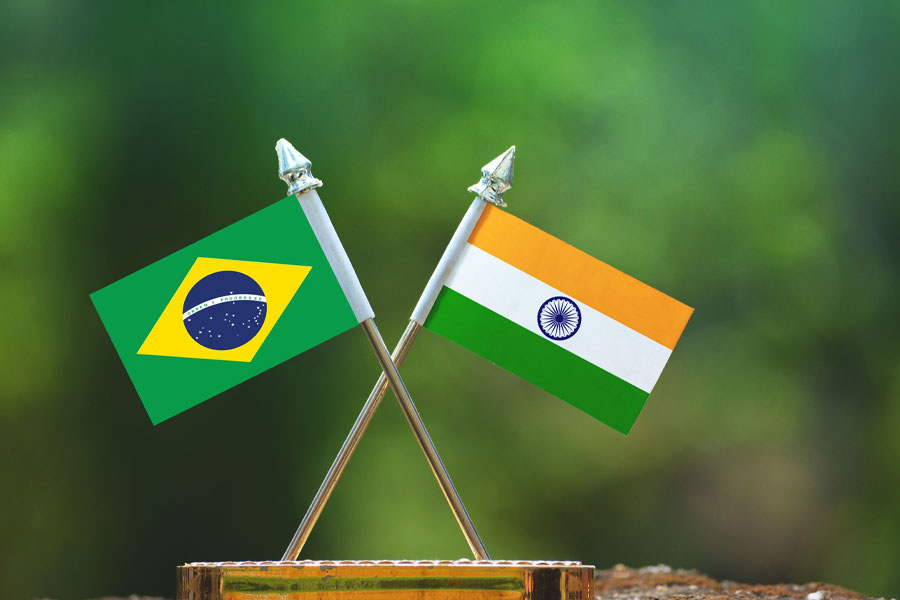
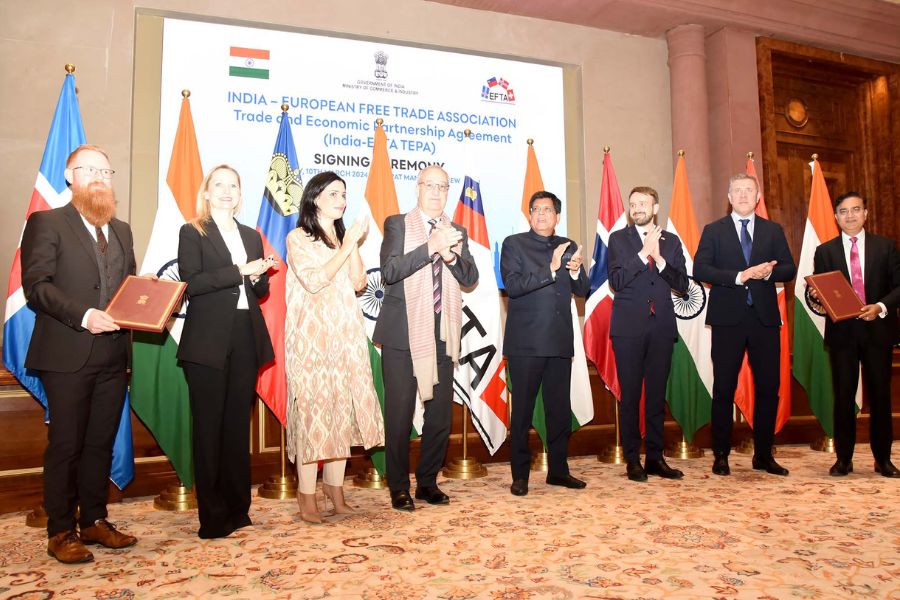
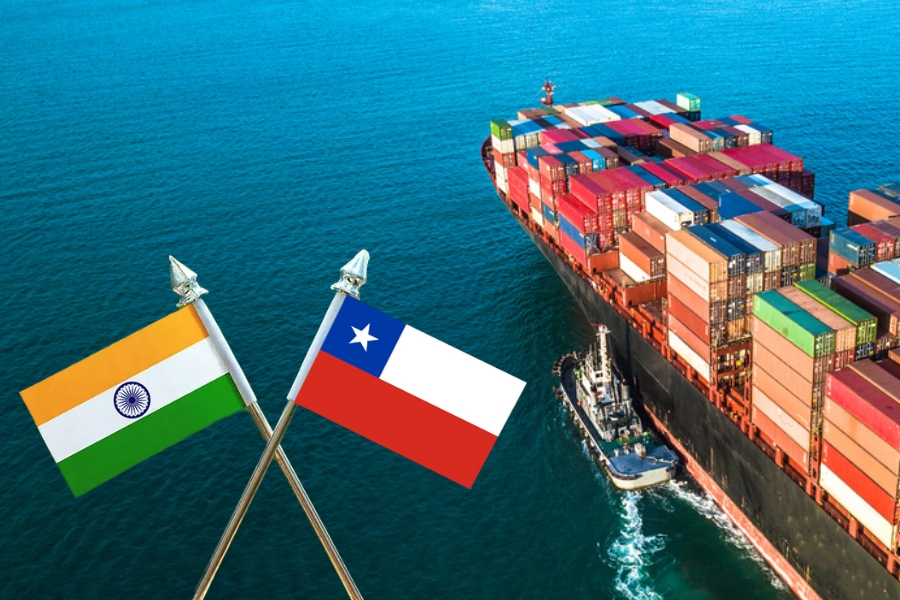
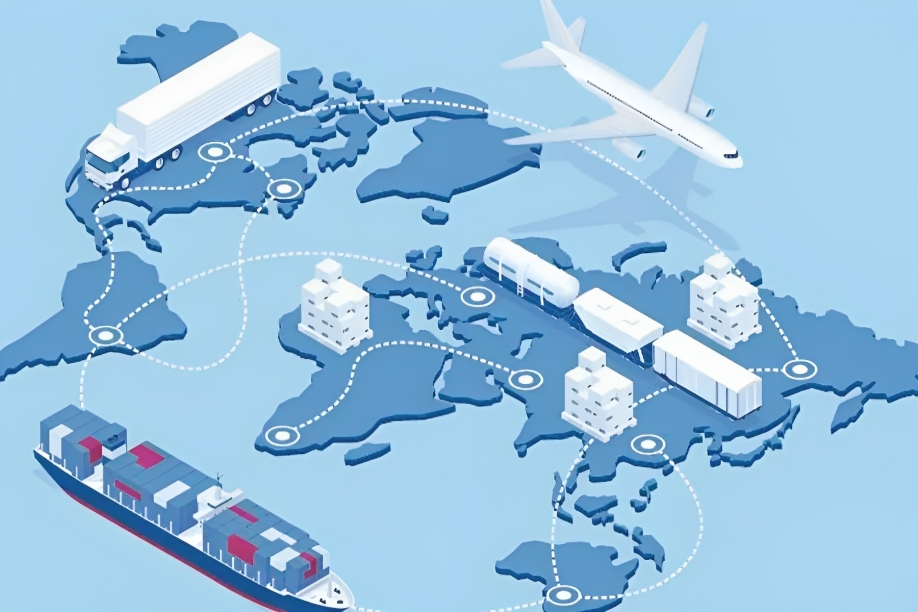

Leave a comment